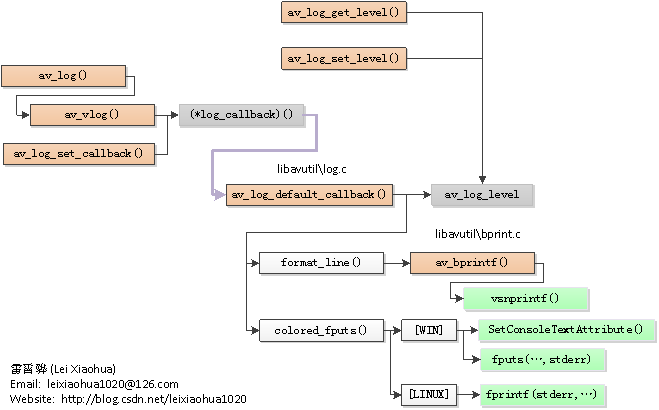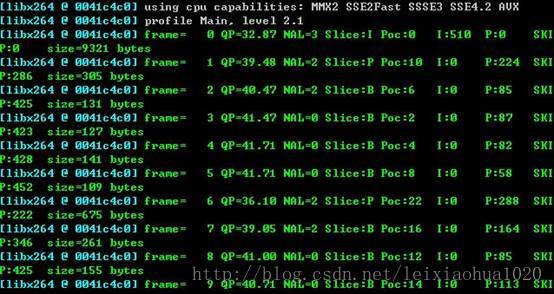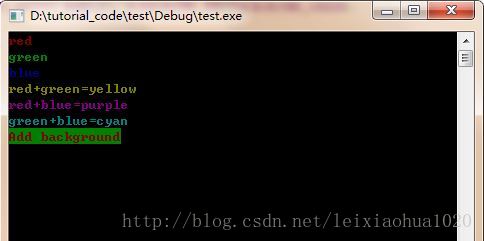简单讲解一下FFmpeg的日志输出系统的源代码。日志输出部分的核心函数只有一个:av_log()。使用av_log()在控制台输出日志的效果如下图所示。
(1)函数最后一个参数是“…”。 在C语言中,在函数参数数量不确定的情况下使用“…”来代表参数。例如printf()的原型定义如下
(2)它的声明后面有一个av_printf_format(3, 4)。有关这个地方的左右还没有深入研究,网上资料中说它的作用是按照printf()的格式检查av_log()的格式。
当前系统存在着一个“Log级别”。所有严重程度高于该级别的Log信息都会输出出来。例如当前的Log级别是AV_LOG_WARNING,则会输出AV_LOG_PANIC,AV_LOG_FATAL,AV_LOG_ERROR,AV_LOG_WARNING级别的信息,而不会输出AV_LOG_INFO级别的信息。可以通过av_log_get_level()获得当前Log的级别,通过另一个函数av_log_set_level()设置当前的Log级别。
下面回到av_log()函数的源代码。它的源代码位于libavutil log.c,如下所示。
av_vlog()的定义位于libavutil log.c中,如下所示。 下面看一下av_log_default_callback()的源代码大致的流程:
看完以上几个与AVBPrint相关函数之后,就可以来看一下format_line()的代码了。例如,part[0]对应的是目标结构体的父结构体的名称(如果父结构体存在的话);其打印格式形如“[%s @ %p]”,其中前面的“%s”对应父结构体的名称,“%p”对应其所在的地址。part[1]对应的是目标结构体的名称;其打印格式形如“[%s @ %p]”,其中前面的“%s”对应本结构体的名称,“%p”对应其所在的地址。part[2]用于输出Log的级别,这个字符串只有在flag中设置AV_LOG_PRINT_LEVEL的时候才能打印。part[3]则是打印原本传送进来的文本。将format_line()函数处理后得到的4个字符串连接其来,就可以的到一条完整的Log信息。下面图显示了flag设置AV_LOG_PRINT_LEVEL后的打印出来的Log的格式。 默认情况下不设置flag打印出来的格式如下所示。
举几个例子:
(1)第一个数字(31)为前景颜色(红色);第二个数字为(42)背景颜色(绿色)
e[40m -- e[47m 设置背景色 echo -e " e[40m" 灰色 echo -e " e[41m" 红色 echo -e " e[42m" 绿色 echo -e " e[43m" 黄色 echo -e " e[44m" 蓝色 echo -e " e[45m" 紫色 echo -e " e[46m" 淡蓝色 echo -e " e[47m" 白色
具体到编程中,printf() 颜色设置示例代码如下所示。

函数调用结构图
FFmpeg日志输出系统的函数调用结构图如图所示。
av_log()
av_log()是FFmpeg中输出日志的函数。随便打开一个FFmpeg的源代码文件,就会发现其中遍布着av_log()函数。一般情况下FFmpeg类库的源代码中是不允许使用printf()这种的函数的,所有的输出一律使用av_log()。 av_log()的声明位于libavutil log.h,如下所示。/** * Send the specified message to the log if the level is less than or equal * to the current av_log_level. By default, all logging messages are sent to * stderr. This behavior can be altered by setting a different logging callback * function. * @see av_log_set_callback * * @param avcl A pointer to an arbitrary struct of which the first field is a * pointer to an AVClass struct. * @param level The importance level of the message expressed using a @ref * lavu_log_constants "Logging Constant". * @param fmt The format string (printf-compatible) that specifies how * subsequent arguments are converted to output. */ void av_log(void *avcl, int level, const char *fmt, ...) av_printf_format(3, 4);这个函数的声明有两个地方比较特殊:
(1)函数最后一个参数是“…”。 在C语言中,在函数参数数量不确定的情况下使用“…”来代表参数。例如printf()的原型定义如下
int printf (const char*, ...);后文中对此再作详细分析。
(2)它的声明后面有一个av_printf_format(3, 4)。有关这个地方的左右还没有深入研究,网上资料中说它的作用是按照printf()的格式检查av_log()的格式。
av_log()每个字段的含义如下: avcl:指定一个包含AVClass的结构体。 level:log的级别 fmt:和printf()一样。由此可见,av_log()和printf()的不同主要在于前面多了两个参数。其中第一个参数指定该log所属的结构体,例如AVFormatContext、AVCodecContext等等。第二个参数指定log的级别,源代码中定义了如下几个级别。
/** * Print no output. */ #define AV_LOG_QUIET -8 /** * Something went really wrong and we will crash now. */ #define AV_LOG_PANIC 0 /** * Something went wrong and recovery is not possible. * For example, no header was found for a format which depends * on headers or an illegal combination of parameters is used. */ #define AV_LOG_FATAL 8 /** * Something went wrong and cannot losslessly be recovered. * However, not all future data is affected. */ #define AV_LOG_ERROR 16 /** * Something somehow does not look correct. This may or may not * lead to problems. An example would be the use of '-vstrict -2'. */ #define AV_LOG_WARNING 24 /** * Standard information. */ #define AV_LOG_INFO 32 /** * Detailed information. */ #define AV_LOG_VERBOSE 40 /** * Stuff which is only useful for libav* developers. */ #define AV_LOG_DEBUG 48从定义中可以看出来,随着严重程度逐渐下降,一共包含如下级别:AV_LOG_PANIC,AV_LOG_FATAL,AV_LOG_ERROR,AV_LOG_WARNING,AV_LOG_INFO,AV_LOG_VERBOSE,AV_LOG_DEBUG。每个级别定义的数值代表了严重程度,数值越小代表越严重。默认的级别是AV_LOG_INFO。此外,还有一个级别不输出任何信息,即AV_LOG_QUIET。
当前系统存在着一个“Log级别”。所有严重程度高于该级别的Log信息都会输出出来。例如当前的Log级别是AV_LOG_WARNING,则会输出AV_LOG_PANIC,AV_LOG_FATAL,AV_LOG_ERROR,AV_LOG_WARNING级别的信息,而不会输出AV_LOG_INFO级别的信息。可以通过av_log_get_level()获得当前Log的级别,通过另一个函数av_log_set_level()设置当前的Log级别。
av_log_get_level(), av_log_set_level()
av_log_get_level()的定义如下所示/** * Get the current log level * * @see lavu_log_constants * * @return Current log level */ int av_log_get_level(void);可以通过av_log_set_level()设置当前Log的级别。
/** * Set the log level * * @see lavu_log_constants * * @param level Logging level */ void av_log_set_level(int level);上述两个函数的定义十分的简单,如下所示。
int av_log_get_level(void)
{
return av_log_level;
} void av_log_set_level(int level)
{
av_log_level = level;
} 从代码中可以看出,以上两个函数主要操作了一个静态全局变量av_log_level。该变量用于存储当前系统Log的级别。它的定义如下所示。 static int av_log_level = AV_LOG_INFO;下面我们看一下H.264编码的时候libx264的Log输出的示例:

void av_log(void* avcl, int level, const char *fmt, ...)
{
AVClass* avc = avcl ? *(AVClass **) avcl : NULL;
va_list vl;
va_start(vl, fmt);
if (avc && avc->version >= (50 << 16 | 15 << 8 | 2) &&
avc->log_level_offset_offset && level >= AV_LOG_FATAL)
level += *(int *) (((uint8_t *) avcl) + avc->log_level_offset_offset);
av_vlog(avcl, level, fmt, vl);
va_end(vl);
} 首先来提一下C语言函数中“…”参数的含义。与它相关还涉及到以下4个部分: (1)va_list变量 (2)va_start() (3)va_arg() (4)va_end()va_list是一个指向函数的参数的指针。va_start()用于初始化va_list变量。va_arg()用于返回可变参数。va_start()用于结束可变参数的获取。有关它们的用法可以参考一个小demo,如下所示。
#include有关这方面的知识很难用简短的语言描述清楚,因此不再详述。av_log()的源代码中,在va_start()和va_end()之间,调用了另一个函数av_vlog()。#include void fun(int a,...){ va_list pp; va_start(pp,a); do{ printf("param =%dn",a); a=va_arg(pp,int);//使 pp 指向下一个参数,将下一个参数的值赋给变量 a } while (a!=0);//直到参数为 0 时停止循环 } void main(){ fun(20,40,60,80,0); }
av_vlog()
av_vlog()是一个FFmpeg的API函数。它的声明位于libavutil log.h中,如下所示。/** * Send the specified message to the log if the level is less than or equal * to the current av_log_level. By default, all logging messages are sent to * stderr. This behavior can be altered by setting a different logging callback * function. * @see av_log_set_callback * * @param avcl A pointer to an arbitrary struct of which the first field is a * pointer to an AVClass struct. * @param level The importance level of the message expressed using a @ref * lavu_log_constants "Logging Constant". * @param fmt The format string (printf-compatible) that specifies how * subsequent arguments are converted to output. * @param vl The arguments referenced by the format string. */ void av_vlog(void *avcl, int level, const char *fmt, va_list vl);从声明中可以看出,av_vlog()和av_log()的参数基本上是一模一样的。唯一的不同在于av_log()中的“…”变成了av_vlog()中的va_list。
av_vlog()的定义位于libavutil log.c中,如下所示。
void av_vlog(void* avcl, int level, const char *fmt, va_list vl)
{
void (*log_callback)(void*, int, const char*, va_list) = av_log_callback;
if (log_callback)
log_callback(avcl, level, fmt, vl);
} 从定义中可以看出,av_vlog()简单调用了一个函数指针av_log_callback。av_log_callback是一个全局静态变量,定义如下所示。 static void (*av_log_callback)(void*, int, const char*, va_list) = av_log_default_callback;从代码中可以看出,av_log_callback指针默认指向一个函数av_log_default_callback()。av_log_default_callback()即FFmpeg默认的Log函数。需要注意的是,这个Log函数是可以自定义的。按照指定的参数定义一个自定义的函数后,可以通过FFmpeg的另一个API函数av_log_set_callback()设定为Log函数。 av_log_set_callback()的声明如下所示。
/** * Set the logging callback * * @note The callback must be thread safe, even if the application does not use * threads itself as some codecs are multithreaded. * * @see av_log_default_callback * * @param callback A logging function with a compatible signature. */ void av_log_set_callback(void (*callback)(void*, int, const char*, va_list));从声明中可以看出,需要指定一个参数为(void*, int, const char*, va_list),返回值为void的函数作为Log函数。 av_log_set_callback()的定义很简单,做了一个函数指针赋值的工作,如下所示。
void av_log_set_callback(void (*callback)(void*, int, const char*, va_list)) { av_log_callback = callback; } 例如,我们可以指定一个my_logoutput()函数作为Log的输出函数,就可以将Log信息输出到文本中(而不是屏幕上)。 void my_logoutput(void* ptr, int level, const char* fmt,va_list vl){
FILE *fp = fopen("my_log.txt","a+");
if(fp){
vfprintf(fp,fmt,vl);
fflush(fp);
fclose(fp);
}
} 编辑好函数之后,使用av_log_set_callback()函数设置该函数为Log输出函数即可。 av_log_set_callback(my_logoutput);
av_log_default_callback()
下面我们看一下FFmpeg的默认Log输出函数av_log_default_callback()。它的定义如下。void av_log_default_callback(void* ptr, int level, const char* fmt, va_list vl)
{
static int print_prefix = 1;
static int count;
static char prev[LINE_SZ];
AVBPrint part[4];
char line[LINE_SZ];
static int is_atty;
int type[2];
unsigned tint = 0;
if (level >= 0) {
tint = level & 0xff00;
level &= 0xff;
}
if (level > av_log_level)
return;
#if HAVE_PTHREADS
pthread_mutex_lock(&mutex);
#endif
format_line(ptr, level, fmt, vl, part, &print_prefix, type);
snprintf(line, sizeof(line), "%s%s%s%s", part[0].str, part[1].str, part[2].str, part[3].str);
#if HAVE_ISATTY
if (!is_atty)
is_atty = isatty(2) ? 1 : -1;
#endif
if (print_prefix && (flags & AV_LOG_SKIP_REPEATED) && !strcmp(line, prev) &&
*line && line[strlen(line) - 1] != 'r'){
count++;
if (is_atty == 1)
fprintf(stderr, " Last message repeated %d timesr", count);
goto end;
}
if (count > 0) {
fprintf(stderr, " Last message repeated %d timesn", count);
count = 0;
}
strcpy(prev, line);
sanitize(part[0].str);
colored_fputs(type[0], 0, part[0].str);
sanitize(part[1].str);
colored_fputs(type[1], 0, part[1].str);
sanitize(part[2].str);
colored_fputs(av_clip(level >> 3, 0, 6), tint >> 8, part[2].str);
sanitize(part[3].str);
colored_fputs(av_clip(level >> 3, 0, 6), tint >> 8, part[3].str);
end:
av_bprint_finalize(part+3, NULL);
#if HAVE_PTHREADS
pthread_mutex_unlock(&mutex);
#endif
} av_log_default_callback()的代码是比较复杂的。其实如果我们仅仅是希望把Log信息输出到屏幕上,远不需要那么多代码,只需要简单打印一下就可以了。av_log_default_callback()之所以会那么复杂,主要是因为他还包含了很多的功能,比如说根据Log级别的不同将输出的文本设置成不同的颜色等等。下图显示了不同级别的Log不同的背景颜色。 
(1)如果输入参数level大于系统当前的日志级别av_log_level,表明不需要做任何处理,直接返回。 (2)调用format_line()设定Log的输出格式。 (3)调用colored_fputs()设定Log的颜色。
format_line(), av_log_format_line()
format_line()用于设定Log的输出格式。它本身并不是一个FFmpeg的API,但是FFmpeg有一个API函数av_log_format_line()调用了这个函数。av_log_format_line()的声明如下所示。/** * Format a line of log the same way as the default callback. * @param line buffer to receive the formated line * @param line_size size of the buffer * @param print_prefix used to store whether the prefix must be printed; * must point to a persistent integer initially set to 1 */ void av_log_format_line(void *ptr, int level, const char *fmt, va_list vl, char *line, int line_size, int *print_prefix);av_log_format_line()的定义如下所示。
void av_log_format_line(void *ptr, int level, const char *fmt, va_list vl,
char *line, int line_size, int *print_prefix)
{
AVBPrint part[4];
format_line(ptr, level, fmt, vl, part, print_prefix, NULL);
snprintf(line, line_size, "%s%s%s%s", part[0].str, part[1].str, part[2].str, part[3].str);
av_bprint_finalize(part+3, NULL);
} 从代码中可以看出,首先声明了一个AVBPrint类型的数组,其中包含了4个元素;接着调用format_line()设定格式;最后将设置格式后的AVBPrint数组中的4个元素连接起来。 在这里遇到了一个结构体AVBPrint,它的定义位于libavutil bprint.h,如下所示。 /**
* Buffer to print data progressively
*
* The string buffer grows as necessary and is always 0-terminated.
* The content of the string is never accessed, and thus is
* encoding-agnostic and can even hold binary data.
*
* Small buffers are kept in the structure itself, and thus require no
* memory allocation at all (unless the contents of the buffer is needed
* after the structure goes out of scope). This is almost as lightweight as
* declaring a local "char buf[512]".
*
* The length of the string can go beyond the allocated size: the buffer is
* then truncated, but the functions still keep account of the actual total
* length.
*
* In other words, buf->len can be greater than buf->size and records the
* total length of what would have been to the buffer if there had been
* enough memory.
*
* Append operations do not need to be tested for failure: if a memory
* allocation fails, data stop being appended to the buffer, but the length
* is still updated. This situation can be tested with
* av_bprint_is_complete().
*
* The size_max field determines several possible behaviours:
*
* size_max = -1 (= UINT_MAX) or any large value will let the buffer be
* reallocated as necessary, with an amortized linear cost.
*
* size_max = 0 prevents writing anything to the buffer: only the total
* length is computed. The write operations can then possibly be repeated in
* a buffer with exactly the necessary size
* (using size_init = size_max = len + 1).
*
* size_max = 1 is automatically replaced by the exact size available in the
* structure itself, thus ensuring no dynamic memory allocation. The
* internal buffer is large enough to hold a reasonable paragraph of text,
* such as the current paragraph.
*/
typedef struct AVBPrint {
FF_PAD_STRUCTURE(1024,
char *str; /**< string so far */
unsigned len; /**< length so far */
unsigned size; /**< allocated memory */
unsigned size_max; /**< maximum allocated memory */
char reserved_internal_buffer[1];
)
} AVBPrint; AVBPrint的注释代码很长,不再详细叙述。在这里只要知道他是用于打印字符串的缓存就可以了。它的名称BPrint的意思应该就是“Buffer to Print”。其中的str存储了将要打印的字符串。 format_line()函数的定义如下所示。 static void format_line(void *avcl, int level, const char *fmt, va_list vl,
AVBPrint part[4], int *print_prefix, int type[2])
{
AVClass* avc = avcl ? *(AVClass **) avcl : NULL;
av_bprint_init(part+0, 0, 1);
av_bprint_init(part+1, 0, 1);
av_bprint_init(part+2, 0, 1);
av_bprint_init(part+3, 0, 65536);
if(type) type[0] = type[1] = AV_CLASS_CATEGORY_NA + 16;
if (*print_prefix && avc) {
if (avc->parent_log_context_offset) {
AVClass** parent = *(AVClass ***) (((uint8_t *) avcl) +
avc->parent_log_context_offset);
if (parent && *parent) {
av_bprintf(part+0, "[%s @ %p] ",
(*parent)->item_name(parent), parent);
if(type) type[0] = get_category(parent);
}
}
av_bprintf(part+1, "[%s @ %p] ",
avc->item_name(avcl), avcl);
if(type) type[1] = get_category(avcl);
if (flags & AV_LOG_PRINT_LEVEL)
av_bprintf(part+2, "[%s] ", get_level_str(level));
}
av_vbprintf(part+3, fmt, vl);
if(*part[0].str || *part[1].str || *part[2].str || *part[3].str) {
char lastc = part[3].len && part[3].len <= part[3].size ? part[3].str[part[3].len - 1] : 0;
*print_prefix = lastc == 'n' || lastc == 'r';
}
} 从代码中可以看出,其分别处理了AVBPrint类型数组part的4个元素。由此我们也可以看出FFmpeg一条Log可以分成4个组成部分。在这里涉及到几个与AVBPrint相关的函数,由于篇幅的关系,不再分析它们的源代码,仅仅列出它们的定义: 初始化AVBPrint的函数av_bprint_init()。 /** * Init a print buffer. * * @param buf buffer to init * @param size_init initial size (including the final 0) * @param size_max maximum size; * 0 means do not write anything, just count the length; * 1 is replaced by the maximum value for automatic storage; * any large value means that the internal buffer will be * reallocated as needed up to that limit; -1 is converted to * UINT_MAX, the largest limit possible. * Check also AV_BPRINT_SIZE_* macros. */ void av_bprint_init(AVBPrint *buf, unsigned size_init, unsigned size_max);向AVBPrint添加一个字符串的函数av_bprintf()。
/** * Append a formatted string to a print buffer. */ void av_bprintf(AVBPrint *buf, const char *fmt, ...) av_printf_format(2, 3);向AVBPrint添加一个字符串的函数av_vbprintf (),注意与av_bprintf()的不同在于其第3个参数不一样。
/** * Append a formatted string to a print buffer. */ void av_vbprintf(AVBPrint *buf, const char *fmt, va_list vl_arg);我们可以瞄一眼av_bprintf()的定义,位于libavutil bprint.c,如下所示。
void av_bprintf(AVBPrint *buf, const char *fmt, ...)
{
unsigned room;
char *dst;
va_list vl;
int extra_len;
while (1) {
room = av_bprint_room(buf);
dst = room ? buf->str + buf->len : NULL;
va_start(vl, fmt);
extra_len = vsnprintf(dst, room, fmt, vl);
va_end(vl);
if (extra_len <= 0)
return;
if (extra_len < room)
break;
if (av_bprint_alloc(buf, extra_len))
break;
}
av_bprint_grow(buf, extra_len);
} 可以看出av_bprintf()实际上调用了系统的vsnprintf()完成了相应的功能。看完以上几个与AVBPrint相关函数之后,就可以来看一下format_line()的代码了。例如,part[0]对应的是目标结构体的父结构体的名称(如果父结构体存在的话);其打印格式形如“[%s @ %p]”,其中前面的“%s”对应父结构体的名称,“%p”对应其所在的地址。part[1]对应的是目标结构体的名称;其打印格式形如“[%s @ %p]”,其中前面的“%s”对应本结构体的名称,“%p”对应其所在的地址。part[2]用于输出Log的级别,这个字符串只有在flag中设置AV_LOG_PRINT_LEVEL的时候才能打印。part[3]则是打印原本传送进来的文本。将format_line()函数处理后得到的4个字符串连接其来,就可以的到一条完整的Log信息。下面图显示了flag设置AV_LOG_PRINT_LEVEL后的打印出来的Log的格式。


colored_fputs()
colored_fputs()函数用于将输出的文本“上色”并且输出。在这里有一点需要注意:Windows和Linux下控制台程序上色的方法是不一样的。Windows下是通过SetConsoleTextAttribute()方法给控制台中的文本上色;Linux下则是通过添加一些ANSI控制码完成上色。Linux下控制台文字上色的方法
Linux下控制台颜色是通过添加专用数字来选择的。这些数字夹在 " e["和 "m"之间。如果指定一个以上的数字,则用分号将它们分开。举几个例子:
(1)第一个数字(31)为前景颜色(红色);第二个数字为(42)背景颜色(绿色)
echo -e " e[31;42m"(2)使用" e[0m"序列将颜色重新设置为正常值
echo -e " e[0m" 或 echo -e " 033[0m"(3)颜色对应关系如下所示: e[30m -- e[37m 设置前景色(字体颜色) echo -e " e[30m" 灰色 echo -e " e[31m" 红色 echo -e " e[32m" 绿色 echo -e " e[33m" 黄色 echo -e " e[34m" 蓝色 echo -e " e[35m" 紫色 echo -e " e[36m" 淡蓝色 echo -e " e[37m" 白色
e[40m -- e[47m 设置背景色 echo -e " e[40m" 灰色 echo -e " e[41m" 红色 echo -e " e[42m" 绿色 echo -e " e[43m" 黄色 echo -e " e[44m" 蓝色 echo -e " e[45m" 紫色 echo -e " e[46m" 淡蓝色 echo -e " e[47m" 白色
具体到编程中,printf() 颜色设置示例代码如下所示。
int main()
{
printf("e[31m Hello World. e[0m n"); // 红色字体
return 0;
}Windows下控制台文字上色的方法
Windows下控制台颜色是通过SetConsoleTextAttribute()函数完成的。SetConsoleTextAttribute()函数的原型如下所示。BOOL SetConsoleTextAttribute(HANDLE hConsoleOutput, WORD wAttributes);其中2个参数的含义如下所示:
hConsoleOutput:指向控制台的句柄。 wAttributes:文本属性。hConsoleOutput可以选择以下3种句柄:
STD_INPUT_HANDLE: 标准输入的句柄 STD_OUTPUT_HANDLE: 标准输出的句柄 STD_ERROR_HANDLE: 标准错误的句柄wAttributes可以控制前景色和背景色:
a
FOREGROUND_BLUE: 字体颜色:蓝 FOREGROUND_GREEN: 字体颜色:绿 FOREGROUND_RED: 字体颜色:红 FOREGROUND_INTENSITY: 前景色高亮显示 BACKGROUND_BLUE: 背景颜色:蓝 BACKGROUND_GREEN: 背景颜色:绿 BACKGROUND_RED: 背景颜色:红 BACKGROUND_INTENSITY 背景色高亮显示控制台文本上色demo代码如下所示。
/** * 雷霄骅 Lei Xiaohua * leixiaohua1020@126.com * http://blog.csdn.net/leixiaohua1020 */ #include程序的运行结果如下图所示。#include int main() { SetConsoleTextAttribute(GetStdHandle(STD_OUTPUT_HANDLE), FOREGROUND_RED); printf("redn"); SetConsoleTextAttribute(GetStdHandle(STD_OUTPUT_HANDLE), FOREGROUND_GREEN); printf("greenn"); SetConsoleTextAttribute(GetStdHandle(STD_OUTPUT_HANDLE), FOREGROUND_BLUE); printf("bluen"); SetConsoleTextAttribute(GetStdHandle(STD_OUTPUT_HANDLE), FOREGROUND_RED|FOREGROUND_GREEN); printf("red+green=yellown"); SetConsoleTextAttribute(GetStdHandle(STD_OUTPUT_HANDLE), FOREGROUND_RED|FOREGROUND_BLUE); printf("red+blue=purplen"); SetConsoleTextAttribute(GetStdHandle(STD_OUTPUT_HANDLE), FOREGROUND_GREEN|FOREGROUND_BLUE); printf("green+blue=cyann"); SetConsoleTextAttribute(GetStdHandle(STD_OUTPUT_HANDLE), FOREGROUND_RED|BACKGROUND_GREEN); printf("Add backgroundn"); return 0; }

colored_fputs()源代码
下面看一下colored_fputs()函数的源代码。static void colored_fputs(int level, int tint, const char *str)
{
int local_use_color;
if (!*str)
return;
if (use_color < 0)
check_color_terminal();
if (level == AV_LOG_INFO/8) local_use_color = 0;
else local_use_color = use_color;
#if defined(_WIN32) && !defined(__MINGW32CE__) && HAVE_SETCONSOLETEXTATTRIBUTE
if (local_use_color)
SetConsoleTextAttribute(con, background | color[level]);
fputs(str, stderr);
if (local_use_color)
SetConsoleTextAttribute(con, attr_orig);
#else
if (local_use_color == 1) {
fprintf(stderr,
"�33[%d;3%dm%s�33[0m",
(color[level] >> 4) & 15,
color[level] & 15,
str);
} else if (tint && use_color == 256) {
fprintf(stderr,
"�33[48;5;%dm�33[38;5;%dm%s�33[0m",
(color[level] >> 16) & 0xff,
tint,
str);
} else if (local_use_color == 256) {
fprintf(stderr,
"�33[48;5;%dm�33[38;5;%dm%s�33[0m",
(color[level] >> 16) & 0xff,
(color[level] >> 8) & 0xff,
str);
} else
fputs(str, stderr);
#endif
} 从colored_fputs()的源代码中可以看出如下流程: 首先判定根据宏定义系统的类型,如果系统类型是Windows,那么就调用SetConsoleTextAttribute()方法设定控制台文本的颜色,然后调用fputs()将Log记录输出到stderr(注意不是stdout);如果系统类型是Linux,则通过添加特定字符串的方式设定控制台文本的颜色,然后将Log记录输出到stderr。 至此FFmpeg的日志输出系统的源代码就分析完毕了。 收藏的用户(0) X
正在加载信息~
推荐阅读
最新回复 (0)
站点信息
- 文章2318
- 用户1336
- 访客11949592
每日一句
Time is gentle, granting you a promising beginning.
岁月温柔,许你一个可期的开头。
岁月温柔,许你一个可期的开头。